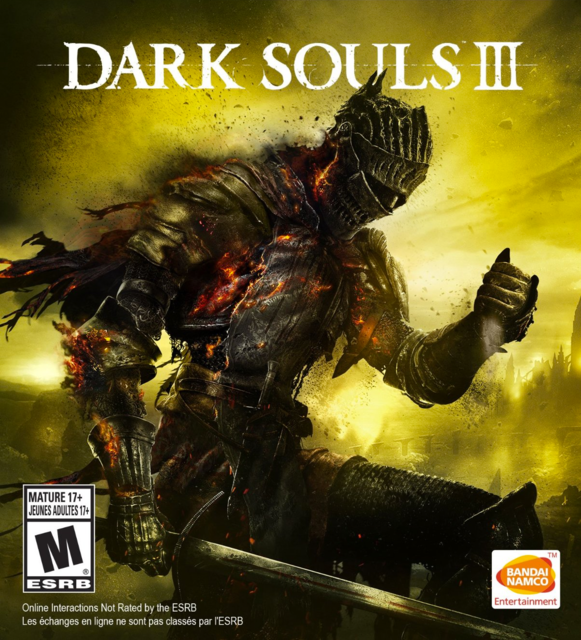
I wish this final Bosswatch entry came to you all in more auspicious circumstances. I spent all of Tuesday night whacking away at the worst monsters From Software could throw at me, but could do nothing to stop the one that just won the Presidency of the United States. I hate to make things political, especially when so many are so sensitive right now, but just know that I'm sorry about what happened and that I hope you all look after yourselves and be an ally for the minorities most at risk.
With that, I suppose I'd better get on with these bosses. This entry's going to go on a little longer than expected; I didn't quite anticipate the amount of content the game still had left after the third Lord of Cinder - of four, though there's technically five - and the various optional areas the game had in store. For spoilers' sake, we're starting directly after the second and third Lords of Cinder all the way up to the final boss, including every optional boss along the way. If you missed the earlier entries in this series, the first part is here and the second part is here.
Dancer of the Boreal Valley
The Dancer announces herself (she's one of the few overtly female bosses in the game) immediately after the player takes down the third Lord of Cinder. Up until this point, the game's bounced between linear and non-linear. There's been a few splits in the path, though only one was truly optional: the Smouldering Lake. When you complete the various branches that lead to the second and third Lord of Cinder, you are immediately warped to a church area found early in the game - right before the Vordt fight, the second boss - and given an item to proceed further into the Castle areas above the city. However, as soon as you try using this item, the Dancer ambushes you. Hence why we start this Bosswatch immediately with a boss instead of a new region.
The Dancer, like Vordt, is a wandering knight of the Boreal Valley that has since turned into a mindless animal through a process that isn't really explained, but could be contributed to Pontiff Sulyvahn's knowledge of forbidden sorceries; however, like Vicar Amelia of Bloodborne, this particular bestial curse seems to affect women differently. Rather than the charging beast Vordt was, the Dancer - true to her name - moves with far more graceful, almost vulpine motions. Her design accentuates her femininity without necessarily going the full boobs and butts route that would be fairly ridiculous for a ten foot tall stooped monster, with the sole exception being her helmet. The helmet has both an intimidating grille, which routinely emits cold foggy breath, and a wispy veil that underscores her dancer-like combat style. It's a neat design, and a good set to purchase if you want gender-appropriate armor for your female protagonist and don't want to resort to the paper-thin dresses of the prayer maidens or Dusk of Oolacile (or just stick her in unisex heavy armor, because what does it matter ultimately? Pfft, Fashion Souls, am I right?).
Which is partly why this boss is so disappointing. She starts strong with that stealthy first impression, but the fight itself feels like a carbon copy of the Pontiff Sulyvahn encounter - she even pulls out a second sword midway through, with matching fire and magic damage - that had way less thought put into its difficulty. In the first half of the fight, she has a poorly telegraphed lunging command grab which is very likely to hit you, and it's instant death. Even while embered, I couldn't figure out how to survive it (though in fairness I haven't really been prioritizing the health stat Vigor). And she'll do it constantly. You can't rely on ranged attacks so much in this one, because she's a large foe in a fairly enclosed space and she's fast enough to close any distance quickly. When she has her second sword, her grab thankfully goes away, but almost all her attacks at this point involve swinging both swords at once in multi-stage combos. It's highly unlikely you'll survive the whole thing if you didn't evade the first hit, since it doesn't take long for those double slashes to deplete your stamina, and she has two variations which usually result in an early demise. Unlike the Pontiff, where you could sort of see how he could be feasibly be recovering stamina between swings with his deliberate tempo, the Dancer seems to have no such barrier when it comes to unleashing devastating combos one after the other. She's a less human opponent, granted, but it felt like a pale shade of the far better structured and tactical Pontiff fight.
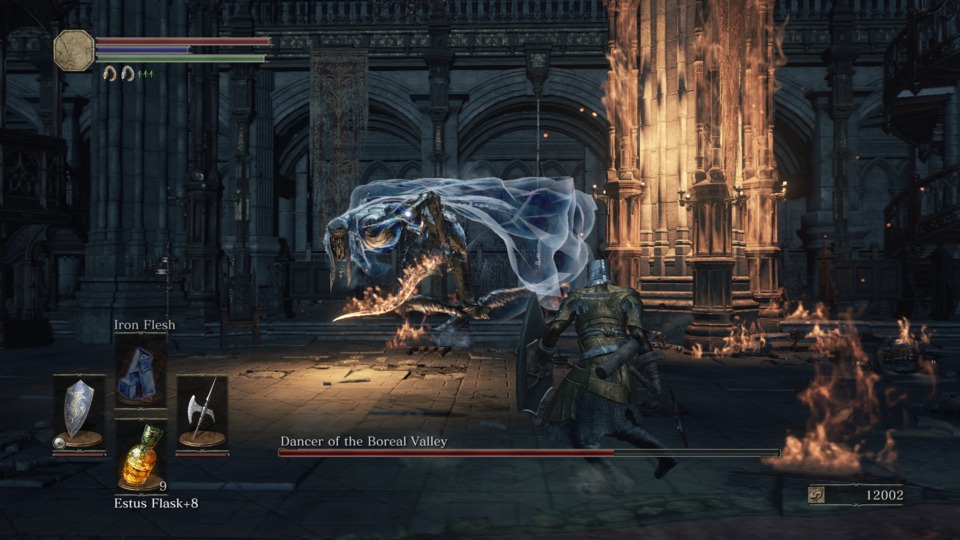
Add that with the fact that she appears out of nowhere, has very little plot relevance and appears long after you've already dealt with the Boreal Valley and its leader and you have a boss that feels thrown in because there was nowhere else to put her. In my headcanon for the development of the game, I imagined a scenario where two groups of designers were working on the major set-piece Pontiff fight, and one came up with the incarnation we faced in Irithyll while the other, lesser creation was left on the wayside until someone decided the game needed an extra boss and just shoehorned it in at an otherwise quiet lull. At least she looked cool?
Lothric Castle
After the Dancer, you are allowed to place the new key item you received to activate a grisly self-beheading statue which opens a staircase to Lothric Castle. The Castle eventually leads to the final Lord of Cinder, who is situated in a throne room at the very top not unlike Dracula in the Castlevania series.
The Castle's perhaps one of my biggest issues with Dark Souls 3, and something I discussed briefly in last week's Sunday Summaries. A lot of the enemies have been brought back from the High Wall region that begins the game after completing the Firelink tutorial area, and all of them have been buffed to remain a threat for the player at their much higher soul level. That means the same weak zombies, masked thralls and slow armored knights, only they're now doing much more damage and their usual tendency to come at you in groups has become far more dangerous. To be clear, they're a greater threat to you at this level than they were back when you first encountered them in the Great Wall as a weakling, even considering the amount of time the player's had to learn their patterns and just generally grow more adept at the game itself.
Design-wise, the external half of the Castle strongly recalls the last area of Boletaria in Demon's Souls or the latter half of the Undead Burg in Dark Souls. There's a lot of masonry that needs navigating around, and you'll be accosted by several more wyverns along the way, who follow the Souls tradition of sitting tight on a piece of rampart and napalming the same area over and over. These particular wyverns (there are two) had a curious trick to them, however: you can resort to a whole bunch of arrows to defeat them, but their bodies will remain present until you destroy their demonic possessors - the same weird blackish serpent things that infected the first boss, Iudex Gundyr, and a few zombies afterwards - which causes the entire wyvern's body to then vanish. I went the arrow route like a coward, but I suspect you could destroy these Las Plagas parasites and remove the dragons that way too, avoiding their firebombing to get around them and remove the real threat. The other enemies are simply variations on what we've seen before, including the overweight halberd knight in the bonfire area of the High Wall and the many other types of Lothric soldiers and knights. The only new type was a robed sorcerer that buffed and healed any knights in the area, and made himself incredibly unpopular (to me) by doing so.
Dragonslayer Armor
Before you reach the boss of Lothric Castle - specifically, he's the boss of the first half that makes up the entire Castle - you have an alternate path to take that sends you to two new optional regions and equally optional bosses. I should make it clear that I only came back around to this guy once I had exhausted that route, but it wouldn't make sense to stick them in here between this boss's region and the boss himself. The optional bosses will be covered below this one.
The Dragonslayer Armor, rather than simply resurrecting Ornstein again, instead merges him with his burly companion Smough to create a heavily armored knight with a strong lightning affinity. The game doesn't cheat here, and manages to make this boss move as slowly as you'd expect from one with so much heavy armor (and a heavy shield). His design is kinda neat, something akin to a variation of Havel the Rock's bulky presentation but with an Ornstein-style lightning spear and his iconic draconian helmet. There's not a whole lot of lore about the guy, but you could feasibly conclude that he was built to resemble one of Gwyn's knights of old: the ones that were equipped for taking down the ancient dragons alongside their king. Curiously, however, the dragons seem to be supporting him this time, with several oddly skeletal dragons hovering around the battlements during the fight.
The boss hits hard, but his range is short and his speed leaves a lot to be desired, and so it becomes the sort of fight where cautiously picking your moment to strike wins the day, rather than the ugly battle of attrition many fights of this type turn into. You could make it out of the fight without a scratch if you spent enough time studying his moves, and it's a satisfying battle because of this strategic interplay. At least, for the first half. As I came to dread for many of the bosses in this game, the second half of the fight adds some nonsense that serves to derail my appreciation for the clever boss design by adding a new wrinkle that makes it far less enjoyable and/or survivable. The halfway switch-up occurs with every boss in the game too, though the switch itself can vary between annoying and interesting. It's nuts that they never feel the need to break away from this particular design crutch of "get them halfway down, then a thing happens and the boss is harder". There's not even a case where there's a three-step process, like the Bloodstained Beast of Bloodborne; the only variation is that it sometimes activates at 60% or 70% of the boss's health instead of 50%. With this fight, the new wrinkle involves the previously passive dragons who now, at random points in the fight with little fanfare, either pepper the bridge with fireballs close to where you're standing or simply send a huge explosion your way. You don't hear or see it coming, because you're focusing too much on the Dragonslayer Armor, and all too often the explosions or fireballs will take you by surprise and wreck you. The best bet is to keep moving throughout the whole fight and hope the odds are in your favor.
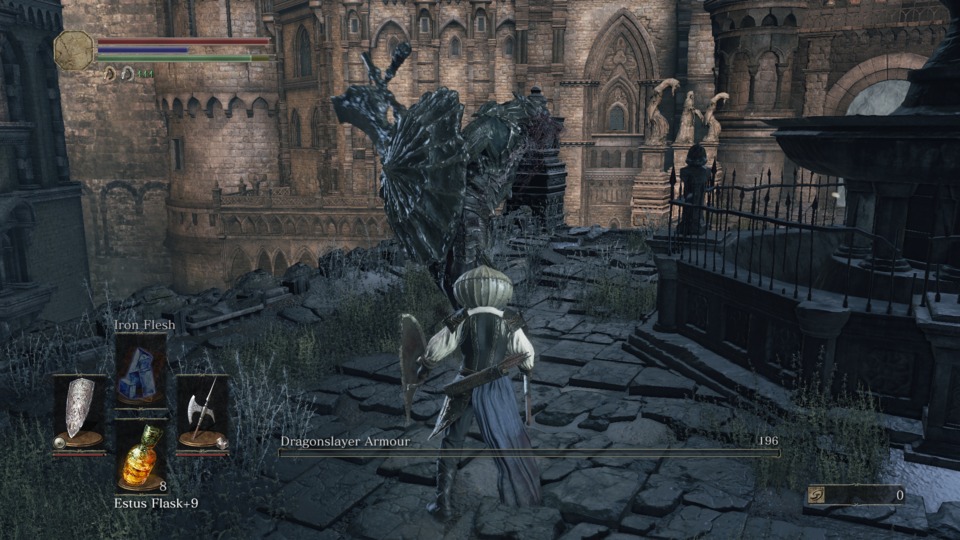
This boss is introduced as one where it's all about the art of the duel: reading your opponent and taking advantage whenever possible to get in a few hits. Being insta-killed by a dragon farting on your back at random intervals is like taking part a heavyweight belt match and having the other guy's manager jump into the ring to whack you with a folding chair from behind. It's heel behavior, and it makes me so mad that A) the fight is cheapened because of it, and B) I cheapened myself by using a pro wrestling analogy.
Consumed King's Garden
This small area breaks away from Lothric Castle, creating a mini-swamp like the Farron Keep region - though this one imparts the far more damaging "toxic" status effect - and packing it with a handful of tough enemies. The region itself is tiny though; it's two courtyard areas one after the other, and the boss appears immediately after. If you didn't mind missing a bunch of stuff, you could sprint from one side to the other without incident.
I wish I could say that this region was interesting, that it spoke to some aspect of the boss that explained why he lived in a garden that had been corrupted so thoroughly that walking through it meant certain death, but it doesn't, really. It's an excuse to force the player to pass through yet another venomous environment and suffer a bunch of status effects they can't easily (or cheaply) cure. There's also a large number of the parasite serpent creatures here too, which I've yet to determine is related to the next boss. You'll see.
Oceiros, the Consumed King
So the reason that Lothric is ruled by a Prince instead of a King is that the King went a bit crazy and was locked away for his own protection. The King has since turned into a reptilian hybrid, the result of his dragon obsession and years of research and study into obscure sorceries, and this is a theme that would recur a little later and was somewhat prominent in Dark Souls 2 as well with the lava dragon boss that was himself previously a human King. He's another boss that feels like an afterthought, or perhaps an idea for a sub-plot that wasn't entirely fleshed out. The game will delve back into dragon worship and the process of becoming a dragon a little later, but Oceiros stands out as being an unusual non-sequitur at this stage of the game. There are no dragons besides the feral wyverns that are feasting on the zombies of the kingdom - a recurring Souls element - and Oceiros speaks frequently about a child named Ocelotte. Ocelotte isn't seen during the fight, but it does appear that Oceiros is cradling something invisible with his non-dominant hand. Far as I can tell, having now beaten the game, the game never expands on this mystery child. The King doesn't talk about his two sons, the Princes, at all either. In fact, I only really assumed Oceiros to be the present King of Lothric: he could well be a distant ancestor that's been locked away in this wing of the castle for centuries.
Oceiros's design recalls that of a human transformed into a dragon, as stated, which was a feature of Dark Souls 2 that appears to have carried over. Through forsaken sorcery, the focus of the experiments of the mad dragon Seath, it is possible for a human to transmogrify into a dragon, if only in part. Oceiros is quite clearly a dragon when you fight him, but he carries himself in an oddly bipedal way that suggests his lower half didn't quite as transform as well as his top half. It's an odd design, but one that definitely hearkens back to Seath and his own unusual top-heavy form. Likewise, Oceiros doesn't appear to have eyes, but doesn't have any problem figuring out where you are.
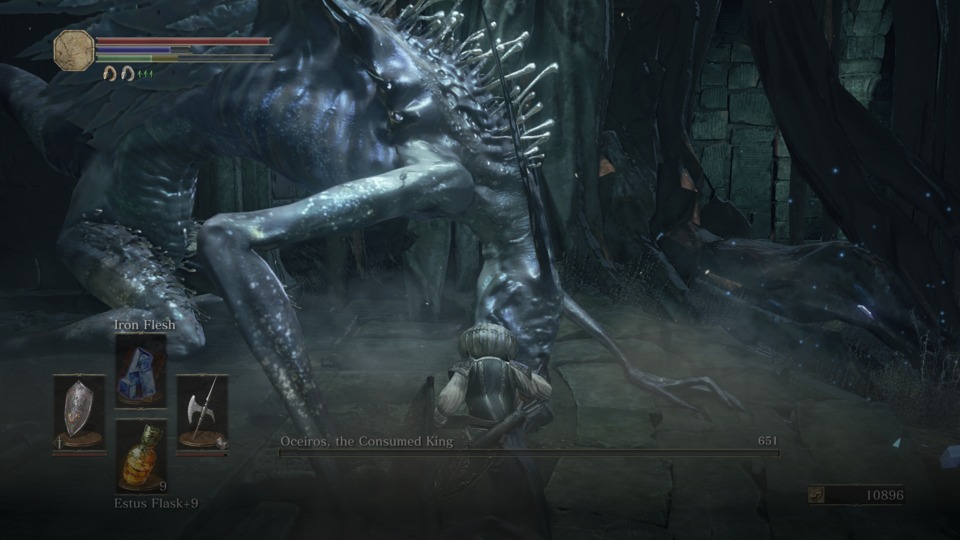
The fight's a curious one. As both a sorcerer and a draconian beast, Oceiros balances ranged magic attacks and fast charging attacks that make him an unpredictable opponent, which perhaps suits his entirely insane disposition. He's a chatty guy too; he rarely stops ranting throughout the whole fight, creating another layer of distraction to deal with. His midway boss upgrade isn't particularly drastic; he simply loses what is left of his marbles and his dragon sweeps and charges become a lot more vicious. Still, he was definitely one of the easier bosses I've fought in the game, thanks in part to a dearth of random back-attacks and instant-kill command grabs. I can appreciate the fight for that much at least.
Untended Graves
Talking of non-sequiturs, Untended Graves brings back a trippy favorite from Bloodborne: an identical clone of the hub area, but far more darker and more dilapidated. It wasn't until the end of the game that I recognized this area's significance, and until then this felt like a weird incongruity. Bloodborne's "Abandoned Old Workshop" became the template for the metaphysical Hunter's Dream due to the first hunter Gehrman, who occupied the real workshop. The powers that created the endless night created the dream, and based it on the memories of Gehrman who became its guardian in the process. However, the Hunter's Dream wasn't a real physical location, and seeing its real-life equivalent after years of abandonment was an interesting tidbit that lifted the veil ever so slightly from the vaguely ominous hub world and its secrets before the end game delved into it in more detail. Conversely, we already know the Firelink Shrine is real, because the NPCs we meet can travel to it and is connected to the bonfire system. It exists, but so too does the Untended Graves.
So what's the deal? Well, there's a hint in the soul description of the next boss, but it doesn't adequately explain how both Firelink Shrine and this place can exist simultaneously. Essentially, this is an aborted cycle where the flame was never kindled and the world fell into darkness, a la the other ending of Dark Souls. The shrine is abandoned, but appears to be a carbon copy, even down to the empty thrones for the named Lords of Cinder. The only NPC present is the elderly Shrine Handmaid vendor, who is hanging onto the last vestiges of her humanity. To talk more about the boss soul item, I'll have to cover the boss himself:
Champion Gundyr
The enemies of the Untended Graves are taken from various areas of the game, creating no real rhyme or reason to their presence: you have the dual-sword-wielding priestesses of the Deep Cathedral and a few black knights that were once scattered across the world, but have been largely absent from this game save for one in the Road of Sacrifices. Gundyr, however, is largely unchanged from his appearance at the start of the game, only here he wasn't brought low by a parasitic serpent, but foiled by darkness conquering the land before he even had a chance to fix it. Both our and this Gundyr, it turns out, is a Champion of Ash just like the player, who happened to start his journey many years earlier. His quest, like yours, was to head to Firelink Shrine, and from there reach the Lords of Cinder and bring them, or their remains, together to ignite the first flame. In the "real" chronology, he was possessed by darkness and pinned to the ground, either by his own hand or by another party, until the player disturbed him and caused his long-since hollowed form to lash out. In this one, the same thing happened; except he was never defeated in battle. Rather, the flame went out before he could help reignite it, and just stayed in the same spot once he realized he had failed, allowing himself to become hollowed in the interim. At least, this is how I'm choosing to interpret it. What fun is Dark Souls if you don't try and put your own spin on the narrative?
Gundyr wasn't "killed" in this timeline, and so he didn't suffer any detrimental affect to his combat prowess. He fights with a similar ferocity as his doppelganger, but does far more damage and has a few additional attacks, like a badass "Duke Boot" kick. However, when he drops to half-health, we discover something unsettling: Gundyr had been corrupted by the darkness after all, as his eyes suddenly light an ominous red and his attacks become far stronger and faster. There's no weird tentacled monstrosity growing from his side this time, but he's even more dangerous with this upgrade. I couldn't tell if this was something he was hiding for the first half of the fight, or if he had the mental discipline to resist the darkness this whole time until the player forced his hand with the prospect of a losing battle. With the tale I spun above, it'd make sense that he'd have a lot of resentment about his failure, and a desire to avoid another one at all costs by falling to this attractive and awesome interloper.
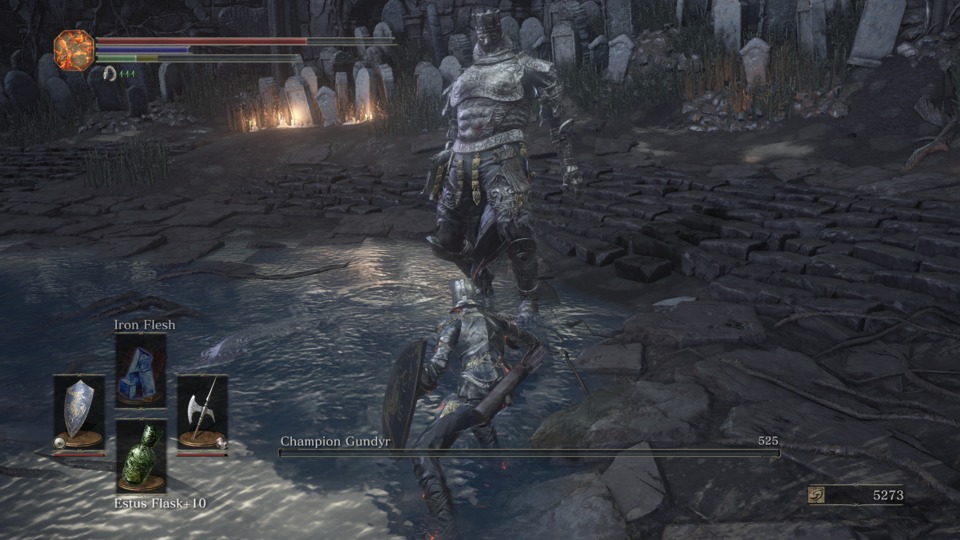
In pure technical combat terms, if not mechanical numerical terms, this was one of the hardest bosses in the game. There was no trick to it, no way to resort to ranged attacks or get him stuck on a corner (the game's generally been very good about not being able to cheese bosses, I should point out). It's just you, Gundyr and a whole lot of aggressive attacks that you either weather with a shield or learn to evade. I appreciated the fight's simplicity, even if it did recall how often Dark Souls 2 would lean heavily on humanoid knight enemies, but it wasn't half difficult to pull off. I think if I could do it all over again, I'd leave Gundyr until after I had the last Lord of Cinder soul. That boss wasn't easy either, spoilers, but at least it didn't feel quite as brutal.
Grand Archives
The second half of the greater Lothric Castle region, the Grand Archives is a classic Duke's Archives exercise in confusion and disorientation. A largely vertical library, the goal of this location is to reach the very top where the final Lord of Cinder awaits. However, between the various staircases, ladders, switches and elevators, it takes some time to get used to the place. Often, you'll need to drop down to a different area in order to make upwards progress. It's a very unintuitive location, and I imagine it must've been a lot of fun to design. Like the Deep Cathedral, the elevators are given the shortcut duty of ferrying the player between the bonfire on the ground floor and various unlocked locations higher up. The roof of the Castle is littered with some of the strongest normal enemies of the game, such as the gargoyles of the Profaned Capital, three golden winged halberd knights (the fat guys), a trio of Bloodborne hunters for some reason, and a whole gauntlet of soldiers and knights that recalled the final staircase of Boletaria. Perhaps most significant, though, was the presence of a second Crystal Sage: the soul of the first, which was fought as a boss all the way back in the Road of Sacrifices, indicated that it was one of a pair of twins. The second is less dangerous, given how strong you were then compared to how you are now, but the large amount of space it can hide in meant it could pepper you with those sorceries without you being able to do a whole lot about it, teleporting further up the Grand Archives to escape your wrath. It required climbing up to the halfway point of the area before you could finish him off and halt the constant overhead crystal magic attacks.
I really enjoyed the design of this place, and some of the oddities it included. One such oddity was the vats of wax that the player could dip their head into, which created a temporary shield from curse-inducing ghostly hands that emerged out of bookshelves in several areas. The mage enemies in this region, too, had wax-covered heads and looked fairly ridiculous. The area was also swarming with the small thralls from the Lothric Castle and Deep Cathedral areas, using their hidden locations to hit you with ambushes. Their weapons looked enchanted here, which might explain how they were able to kill you in two or three hits (unless they jumped on you from behind, in which case you're done, son). A lot of hard-to-spot switches would move bookcases around, opening secret areas and shortcuts, and it felt like a lot of work went into its intricate level design.
Younger Prince Lothric
"Younger Prince Lothric" is sort of a misnomer for this boss. The real target is indeed the younger of two Princes, who was brought asunder due to his own blood - it's implied that a lot of in-breeding in the royal family caused some genetic abnormality, which is a bit on the nose for a Brit - but the boss fight is actually against his older brother Lorian, a powerful knight. Lorian, in sharing his brother's "curse", is apparently crippled and mute. I wasn't sure if by curse the game meant that both brothers had various disabilities due to their recursive family tree, or if the elder brother chose to sacrifice some part of himself to keep his frail twin alive.
Lorian isn't an easy opponent. While his attacks are slow and predictable, because he can't really move around much, his tendency to teleport after every other swing added, let's say, a touch more mystery to how he was going to slice at you next. This could either mean a physical swipe from your immediate behind, or teleporting some distance away so that he could hit you with a devastating charged downward slash that created a wave of energy. Even while embered, this attack still took off almost my entire health bar, meaning I had to stay at full health if I intended to survive it. Or, I could dodge out of the way, but that wasn't always feasible due to the wave's surprising width.
The fight doesn't have a traditional halfway point. Rather, you keep fighting Lorian until he ignites his sword and comes at you with a stronger fire-tinged attack, and then after that until his health bar has completely drained. At this juncture, the younger brother comes down from his bed and joins his brother in the fight, draping himself on his back and resurrecting him. The pair together suddenly generate two new health bars, one each, and come at you with renewed vigor. I really did not care for this development: the Abyss Watcher fight resembled this, but a single Watcher wasn't a particularly challenging opponent, and Lorian was plenty difficult just on his own. Worse, however, is what happens when you focus on Lorian and don't hit Lothric on his shoulders - which requires an overhead swing, since he's higher up. If Lorian dies before Lothric, Lothric simply resurrects him again. You have the best shot at Lothric you could hope for while he's doing this, but you're more than likely to have to face Lorian for a third time even if you try focusing on attacks that hit both brothers together. Fortunately, if Lothric dies the fight is immediately over, so it could feasibly be possible to just avoid hitting Lorian and focus entirely on Lothric. He doesn't make it easy though, not with his homing arrows and other sorceries, which he irritatingly fits in after his brother's combos to add to their length.
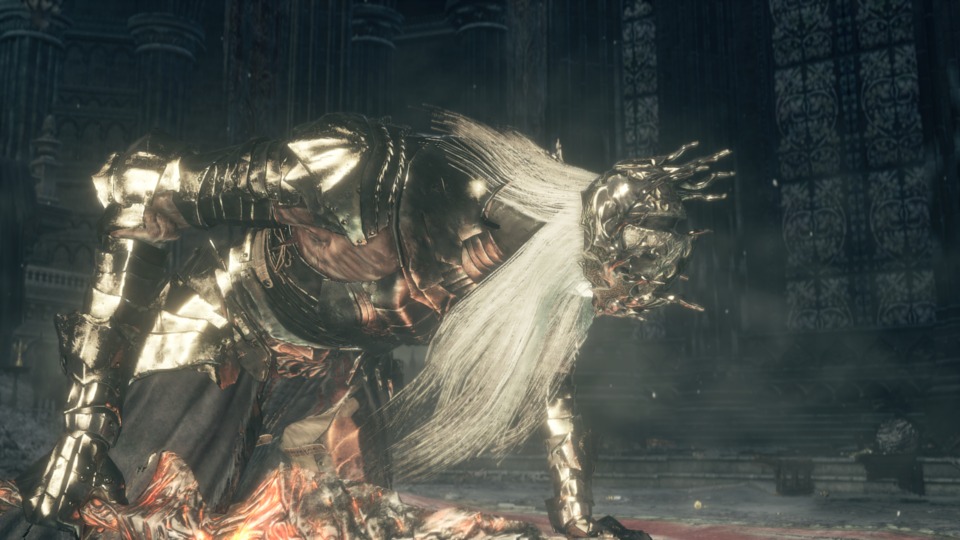
I can't be too mad at this fight though, regenerating health bars aside. It's a smart way of demonstrating that it's the younger, weaker brother who actually has all the power, and that the elderly brother is so devoted to his sibling that he suffers death over and over to defend him. It's a plot-significant boss that is able to highlight the backstory behind its characters in a gameplay congruous manner, and those are rare and precious occurrences. A fitting fourth Lord of Cinder fight.
Archdragon Peak
Archdragon Peak, the final of the optional areas, took some sleuthing to reach. The only hint was a corpse sitting in a particular Yoga-style sitting pose in the Untended Graves which matched that of a series of corpses lined up across a cliff path back in the Irithyll Prison. By learning the gesture from the Untended Graves corpse and sitting alongside those in the prison with the same pose for a certain amount of time, you end up being transported to a mountain temple you can just about see off in the distance. It is every bit as abstract as ducking with a red crystal until a tornado takes you away in Castlevania: Simon's Quest, right down to there being a moderate delay until the cutscene activates that's just long enough to make you wonder if there's any purpose to this completely ridiculous thing you're doing.
The Peak is fairly nondescript, really. It's a shattered shrine high up in the mountains, and it's quite a bit brighter than the rest of the game. At some point, the designers thought they'd reintroduce the red sky and creepy moon of Bloodborne after certain events in that game's story made the world a slightly less sane place, but it makes far less sense here in Dark Souls 3 (much like the copycat Untended Graves, too). In comparison, the ruins of the Peak have a lot more sunshine, though it serves as a stark reminder just how badly the structures up here are decaying, and are therefore presumably that much more ancient. Almost all the enemies here look like Yoel - the first NPC vendor you meet in the wild, who reintroduces hollowing back in the Souls series as a sinister shortcut to power - only the cowls are hiding serpent heads that snap forward with devastating attacks. It's not quite the man-serpents of Sen's Fortress, but it's close enough. The goal of this isolated bonus area is to pledge your allegiance to dragonkind by completing a pilgrimage to the altar at the very end of the location and praying there with the same gesture you used to reach the area. It's not easy though, in part due to a vast number of powerful man-serpent enemies and two bosses.
(Also in this area? Havel and Ricard! It's been a long time since I saw those two, and they're both just as nasty as I remember them.)
Ancient Wyvern
The first boss of Archdragon Peak, the wyvern fight initially resembles that of the Ancient Dragon of Dark Souls 2, which can be aggroed into an optional battle that's extremely difficult to win - indeed, even the names are similar. However, while attempting to fight the wyvern directly is folly and will get you torched by its fire attack, there is a means to run past the wyvern and enter a series of passageways filled with enemies. It's here that the true fight is situated.
The Ancient Wyvern doesn't offer much new with its visual design. It is almost literally an upscaled (so to speak) version of the wyverns you fight in Lothric, down to the white coloration and jagged natural armor. The idea being that, while you could feasibly cheese those lesser wyverns with arrows due to their limited mobility and fire breath range, this Ancient Wyvern has no such limitations. It's not an opponent you can hope to destroy from a safe distance, and stays well out of reach for a more melee-focused approach. Even if you did assault it while it was on the ground by hacking at the feet, all you're doing is giving it a pedicure until it gets bored enough to sit on you.
After eliminating a gauntlet of tough enemies, all the while dodging the fire breath of the wyvern, you eventually reach an overcrop that lets you drop attack it directly on its head. Which kills it instantly. Kind of odd, but it's a badass way to finish a fight and hearkens all the way back to Demon's Souls where you had to eliminate an immense dragon opponent through largely indirect means, making the fight all about dodging breath attacks until you could activate the win state. Many fans of this series don't care for the requisite "puzzle boss" fight in these games, but I don't mind the change of pace.
Nameless King
The other boss is truly optional: a bell can be rung close to the end of the area, and in so doing it summons a pack of stormclouds that blankets the entire region. By stepping out onto the stormclouds close to the bell, the player can actually walk on top of them and find a long corridor in the sky that triggers the next boss. It's an event as impressive as the boss himself: The King of Storms.
The King of Storms doesn't so much refer to the knightly character in this fight than the blue wyvern he is riding, and the duo attack like a Dragonlance villain. The wyvern takes damage hard, but he's also very maneuverable and the rider is taking potshots at you the entire time with his immense lightning lance. The goal of this fight is to close the distance before he can swat you with a powerful bolt or a lance thrust and get in some damage before he moves again. Once the wyvern is down - no mean feat - the boss health bar regenerates and you're faced with the Nameless King himself.
The subsequent fight is very deadly up close. The Nameless King fights like Gundyr, only most of his attacks come packed with lightning elemental energy which is hard to mitigate effectively. Your best bet is to use range against him and draw a bow - this is both effective during the wyvern stage and the on-foot stage, since the Nameless King strolls unhurriedly towards you like a complete badass (I've used that word a lot, and yet it never stops being applicable...). Even with the bow and his gait, however, there's a lot of dodging to be done. Of particular note is a two-stage attack where he sends a horizontal wave of energy your way, which you actually have to evade roll over to effectively dodge, and then an immediate second wave follow-up that is far more narrowly focused, like Lorian's. The fight was an endurance contest, where the number of times you could mess up equaled the number of Estus flask swigs in your possession.
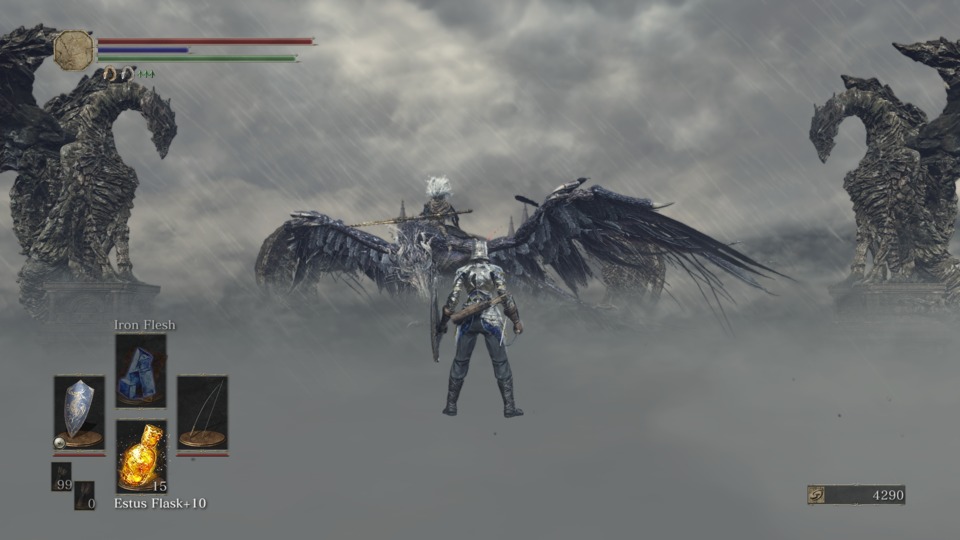
The coolest part about this fight is the Nameless King's backstory, however. Rather than regurgitating the lore of Dark Souls 1 and 2, in a "see what this NPC/region is like now!" referential sense, the Nameless King fills in a dangling plot thread: he is the eldest son of Lord Gwyn, who mysteriously disappeared long before the events of that game and is only referred to in passing. The backstory from that game paints the Nameless King has an unequalled god of combat that nonetheless lost his way due to some "folly" and was excised from the history books. That folly seems to have involved throwing his lot in with the dragonkind - it makes sense that Gwyn would disown him over this, given dragons were his (im)mortal enemy. Super cool boss, and one of the most fun to fight, even if I did cheese him with arrows. Like I was going to go near that guy...
Kiln of the First Flame
After restoring the four dead Lords of Cinder to their thrones in Firelink, they and the friendly NPC Ludleth disintegrate and pass their essence onto the player character, giving them the power to reignite the first flame. In so doing, the player is transported to another "dead" Firelink Shrine: one where the walls have all collapsed and looks even more ancient than the one in the Untended Graves. I think this was supposed to be the first Firelink Shrine, since it connects directly to the Kiln of the First Flame.
The Kiln is weird. Whereas in Dark Souls it simply resembles a giant bowl sitting over Izalith, in this one it resembles an interdimensional location that is adjacent to a maddening cube of random architecture from the various regions of Lordran, Drangleic and Lothric. It's a hodgepodge formed from many millennia of kingdoms rising and falling in service to the first flame, suggesting that the three cycles we've seen in the games were just three drops in the bucket. It's an awesome sight, but it's also the only thing here besides the boss arena at the very end: there's no last-minute attempts to troll you with black knights and precarious walkways before reaching the boss. I suppose such a stage would distract from the importance of this final battle, and presumably why every game since has had a clearly demarcated final boss arena that requires no effort to reach. It wants you to save all your energy (and Estus) for its final encounter.
Soul of Cinder
If you've been wondering about the guy on the box art, as I have, he's actually this guy. The final boss. The amalgamated Lord Souls manifested into one entity that challenges you to ensure you're prepared for the momentous task of linking the first flame. Either that, or they're sore losers who want to see you fail by uniting together. Either way, he looks like a regular knight enemy, but hardly fights like one.
The Soul of Cinder's whole gimmick is a versatility borne of his disparate parts. That means that at various points in the fight he'll suddenly adjust his fighting style and come at you with a different approach. He jumps between a standard broadsword fighting stance that resembles those of the knights you've been fighting for the whole game; a sorcery-focused build that peppers you with magic from a distance; a pyromancy-focused build that alternates between a dervish-inspired curved sword fighting style interspersed with random pyromancy spells like fireballs, strength buffs and poison mists; and a faith-focused build that uses a lance to hit you from range and miracles that allow him to heal himself or create large concussive bursts that send you flying. The versatility works both for him and against him: the unpredictable nature of his attacks keeps you guessing, but some forms are easier to deal with than others. Once you drain his health bar, though, the game throws another spanner into the works.
Digression: I actually sort of hate this particular development in DS3's boss fights, and I don't know why it comes at the late game instead of used for the entire length. I realized I just decried the game's use of having bosses change the game at the midway point, but this isn't really anything different; instead of a large health bar that triggers the change once it is half drained, we get two smaller health bars that appear consecutively. It's done purely for the sake of a single surprise; because of course, once you've seen them regenerate their whole health bar once, the trolling effect of seeing them come back again is lost. I guess my only real issue with this is one of consistency. At a certain point, instead of having every boss change their approach because their health bar was half gone, they do so because... well half their health is gone, but in a less obvious way. It'd be like if the health bars suddenly started draining in the other direction, or had multiple colored bars that you had to drain. I'm all for variation, but it's just odd when it changes absolutely nothing about the actual mechanics of the fight, just the visual feedback for how much progress you're making. Weird stuff.
Anyway, the second half of this fight, or the second of its two consecutive fights depending on how you choose to unwrap the mess above, involves the Soul of Cinder resorting to a single combat style: that of Lord Gwyn's. Now armed with a flaming ultra greatsword, the Soul attacks very much like Gwyn did, including a devastating five hit combo that is almost impossible to evade unless you see the warning signs and get the hell out of range. He also has the same command grab that Gwyn (and the Dancer) had, though the resulting unavoidable attack is fortunately far more survivable. This mode has slightly less health than the previous, but the attacks are far more damaging and it requires a great deal of caution. Seeing that combo is a good time to roll back about five times, and then draw a bow and give him some arrow-y business while he completes the ridiculously long chain.
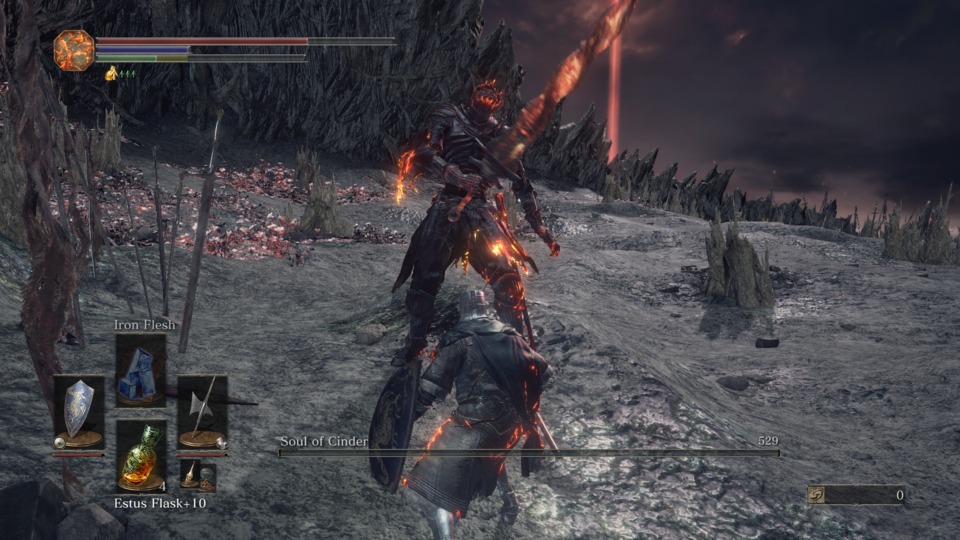
The boss is a good one: it's all about pattern memorization and reflexes, like any good Souls boss, and while "the gestalt entity comprised of everyone you've slain" is kind of an ass-pull for a final boss, especially since these Lords presumably still want someone to link the flames and keep humanity going for another eon, it's a neat idea and a cool looking nemesis to stand between you and your destiny. Sometimes a good boss doesn't need to be a gigantic skeleton sliding into the abyss or a dragon-riding king in a sea of clouds, it just needs to have enough variation and danger to give you a run for your money.
That's going to do it for this episode of Bosswatch, and the series itself for a while. For what I believe is the first time, I've reached a point like many of you where I have no currently available Souls game left to play. Well, besides the NG+ of those I've left behind and the many DLC campaigns I don't feel like shelling out for. I don't think I like Dark Souls 3 enough to give it another turn; I've spoken about how the game reductively recycles its enemies and locations for the sake of some big lore-unifying process, and while the overall boss quality is higher than DS2 it felt a lot more "safe" than that one did in every other respect. More by the numbers. It's like the Jurassic Park movies: the first will forever remain a timeless classic, the second was weird and divisive but at least had some distinctiveness to call its own, and the third just treads water by reusing many of the same old surprises and turns of the previous two to the extent that it basically does fine but is unlikely to be anyone's favorite.
Of course, I'm open to more thoughts on how the game compares to its predecessors, or any of the bosses I've written about above. Anything I'm missing? (And, man, I apologize for the length on this one. All that extra content really snuck up on me.)
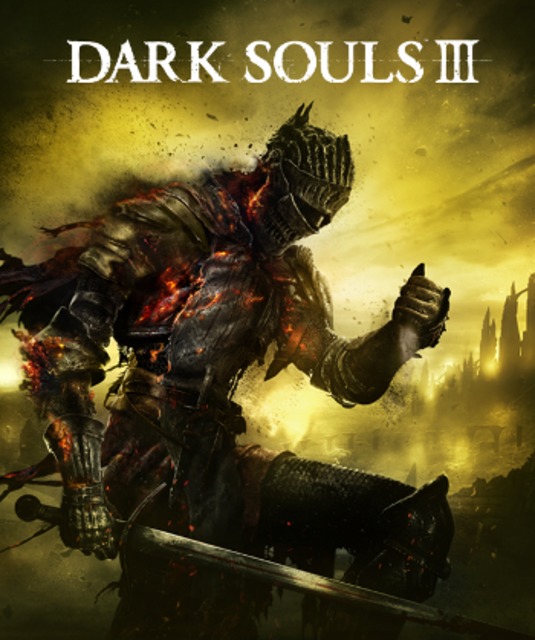
Log in to comment